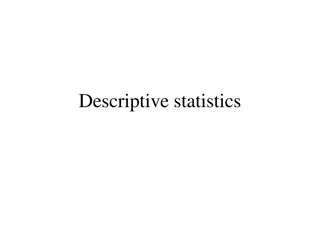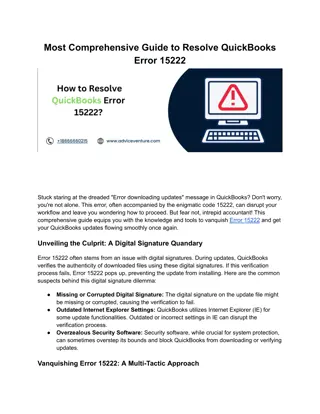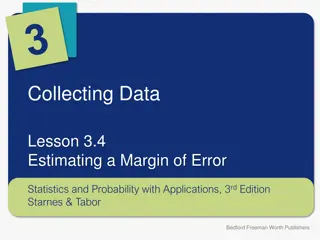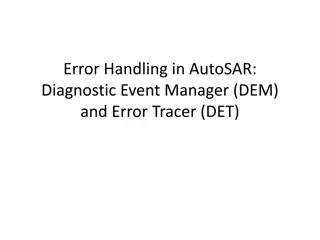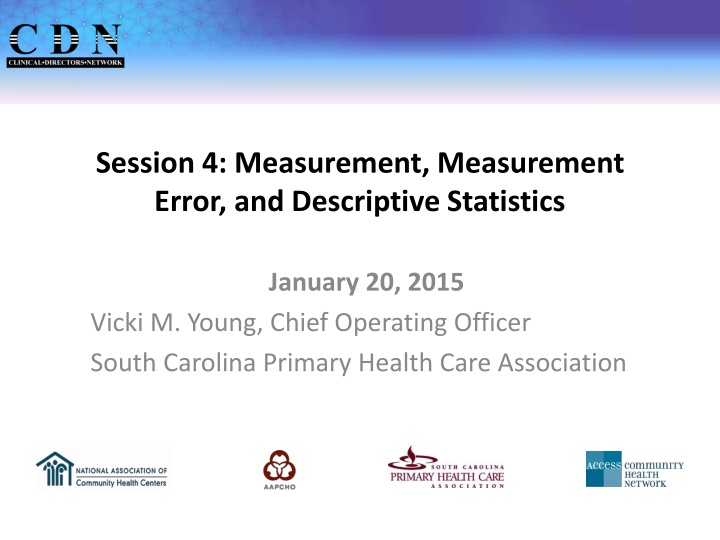
Measurement and Measurement Error in Health Services Research
Explore the concepts of measurement and measurement error in health services research, including levels of measurement, error reduction techniques, and descriptive statistics. Gain insights into specifying concepts, operationalizing questions, and identifying variables in research projects.
Download Presentation

Please find below an Image/Link to download the presentation.
The content on the website is provided AS IS for your information and personal use only. It may not be sold, licensed, or shared on other websites without obtaining consent from the author. If you encounter any issues during the download, it is possible that the publisher has removed the file from their server.
You are allowed to download the files provided on this website for personal or commercial use, subject to the condition that they are used lawfully. All files are the property of their respective owners.
The content on the website is provided AS IS for your information and personal use only. It may not be sold, licensed, or shared on other websites without obtaining consent from the author.
E N D
Presentation Transcript
Session 4: Measurement, Measurement Error, and Descriptive Statistics January 20, 2015 Vicki M. Young, Chief Operating Officer South Carolina Primary Health Care Association
Presenter Vicki M. Young, PhD Chief Operating Officer South Carolina Primary Health Care Association
Homework Follow-up Session 3 Finalized Community Engagement Process Research Question Confirmed Research Design Selected Variables Selected Discussion of Potential Selection Bias Assessment of Health Center Capacity to Conduct and Resources Needed
Training Goals Review and Discuss Measurement in Health Services Research Review Types of Measurement Error and Ways to Reduce Measurement Error Review Descriptive Statistics Utilized in Health Services Research
Definition Measurement is the process of specifying and operationalizing a given concept. In this instance, the research question (concept) is detailed to the point that all components of the question are defined Source: Shi, L.(2008) Health Services Research Methods (2nd ed.). Delmar Cengage Learning
Levels of Measurement The level of measurement describes the relationship among the determined values of a variable Variable- Gender Attribute- Male, Female Value- 1,2 Relationship- categorical
Levels of Measurement Four Levels Nominal - values describe categories of a variable (e.g., gender) Ordinal- values may be rank ordered (e.g., patient use of health education materials) Interval- values rank ordered and separated by equal amount (e.g., body temperature) Ratio- like interval, except, these measures are based on a true or valued zero point (e.g., visits measured in days 0 days has a value) Let s Share- What Examples Do You Have? Indicate the measurement level for variables being considered for projects
Measurement Error After measurement type/level has been established and data collected, observed differences can be attributed to true differences and/or error in measurement True difference is what you re trying to capture Measurement error is what you want to avoid or diminish Measurement error is responsible for differences that are not due to true differences between the elements/groups being studied
Measurement Error Two Types Systematic Random Systematic Inaccurate definition of the concept being studied Important dimensions or categories of dimensions not included Ambiguous formulation of research question Research experience May be introduced by observer, subject, or instrument Bias in measurement Therefore important to spend adequate time discussing how the concept of interest will be operationalized and measured
Measurement Error Random (Non-systematic) Characteristics of participants affect the measurement process May be introduced by observer, subject, or instrument Difference in attitude that affects the observation Observer/Interview understanding in training Systematic error is greater threat to a study than random error Seek to reduce measurement error where possible At a minimum, study the potential error so it can be addressed and/or described
Internal Validity Chance Association ? Bias Confounding Causation ? External Validity Generalizability Source: Harvard Community Catalyst. Building Primary Care Research Infrastructure at Your Community Health Center. Module 1: Research and QI
Reduction in Measurement Error Validate or Use Previously Validated Measurement Tool or Procedure Train Observer/Researcher Validate Data Entry Take time to review data once entered Conduct Statistical Procedures Increased Repetition in Measurement Greater number of data points Use More than One Measure of the Same Variable
Definition and Types Descriptive statistics quantitatively describe the main features of a collection of information or data. Summarizes characteristics of groups in a manageable way Univariate Analysis (examines characteristics of one variable at a time) Central Tendency Dispersion Distribution Central Tendency Mode Median Mean Source: Mann, P. S. (1995). Introductory Statistics (2nd ed.). Wiley
Types (cont.) Dispersion /Variability Range Variance Standard Deviation Distribution Frequency Percentage
Measures of Central Tendency Provides summary of information about a central value Mode Value of the data points (distribution) that occurs most frequently Most often used with nominal level data Median Mid-point of a distribution of data points Most often used with ordinal, interval, and ratio level data Not affected by extreme values
Measures of Central Tendency (cont.) Mean Arithmetic average- xi/ N (x- observed values, N- total number of observations) Most commonly used measure of central tendency Only used with interval and ratio level data Arithmetic properties are useful in inferential statistics Extreme values do affect the mean
Measures of Dispersion/Variability Refers to spread of the distribution of observations Range Difference between highest and lowest value of a distribution Used with ordinal, interval, and ratio data Only takes maximum and minimum values into consideration Variance Depicts the extent of the difference between the mean and each observation in the distribution Average squared deviation from the mean Variance = (xi- mean)2/ N-1 Used only with interval and ratio data
Measures of Dispersion/Variability Standard Deviation More accurate and detailed measure of dispersion than range More intuitive measure of variability Square root of variance Used only with interval and ratio level data
Measures of Distribution Distribution is a summary of categorized values of a variable Graphically, the density function of a normal distribution is what we refer to as the normal or bell curve Frequency Distribution Number of cases per category Percentage Distribution Number of cases per category divided by the total number of cases multiplied by 100 Example Frequency of staff by position type (i.e., administrative, clinical, support) Let s Share- Think about QI projects your organization has conducted Share use of frequency/percentage to describe distribution
Other Measures Standardizing Operations or Measures Ratio Frequency of observations in one category divided by the frequency in another category Example Ratio of children to adults with missing BMI measures during a calendar year Rate Number of cases/events in a category divided by the total number of observations multiplied by 100 or 1000 Example Birth rate- number of births in a population per 1,000 Let s Share! What rates or ratios have the biggest impact/burden in your communities?
Other Measures Measures of Morbidity Incidence Number of NEW cases of a disease Defined population Specified time period Prevalence Number of cases of a disease Defined population Specific point in time Measure of Risk Attributable Risk Difference in rate of a disease/condition in an exposed population and the rate in an unexposed population Difference in risk of exposed and unexposed individuals
Measure of Association Bivariate Measures Relative Risk (RR) Measures strength of association between independent variable (e.g., risk factor) and an outcome (occurrence of event) Risk of developing an outcome based on exposure to independent variable RR= Incidence in exposed group/ Incidence of disease in unexposed group Use in prospective studies randomized clinical trial or cohort study Confidence Interval Estimated range that is likely to include the value of the variable/indicator of interest Calculated from sample data. Source: Easton, V.J. Statistics Glossary (v1.1).
Measure of Association Bivariate Measures Odds Ratio (OR) Measures strength of association between independent variable and an outcome (occurrence of event) Ratio of the odds of developing a disease (an outcome) given exposure ( independent variable) and the odds of developing the disease given non-exposure Used in retrospective- case-control studies In rare conditions, OR approximates the RR
Internal Validity Chance Association ? Bias Confounding Causation ? External Validity Generalizability Source: Harvard Community Catalyst. Building Primary Care Research Infrastructure at Your Community Health Center. Module 1: Research and QI
Questions? Discussion
Homework Complete/Answer the Following Tasks/Questions Define and finalize the testable hypothesis Are outcomes clinical outcomes or patient centered outcomes (care delivery/systems)? Identify the main outcome (dependent variable) Identify independent variable(s) Identify potential bias and confounders Has a database been identified? Has appropriate statistical software been identified? Determine appropriate descriptive statistics to perform
Sources Shi, L.(2008) Health Services Research Methods (2nd ed.). Delmar Cengage Learning Harvard Community Catalyst. Building Primary Care Research Infrastructure at Your Community Health Center. Module 1: Research and QI Source: Mann, P. S. (1995). Introductory Statistics (2nd ed.). Wiley Easton, V.J. Statistics Glossary (v1.1).
Next Webinar Sample Size, Power Calculations, and Sampling Methods Tuesday, February 17th 3:30 5:00 pm EST
Thank You! Vicki M. Young, PhD Chief Operating Officer, South Carolina Primary Health Care Association T: (803) 788-2778 E: vickiy@scphca.org 32



